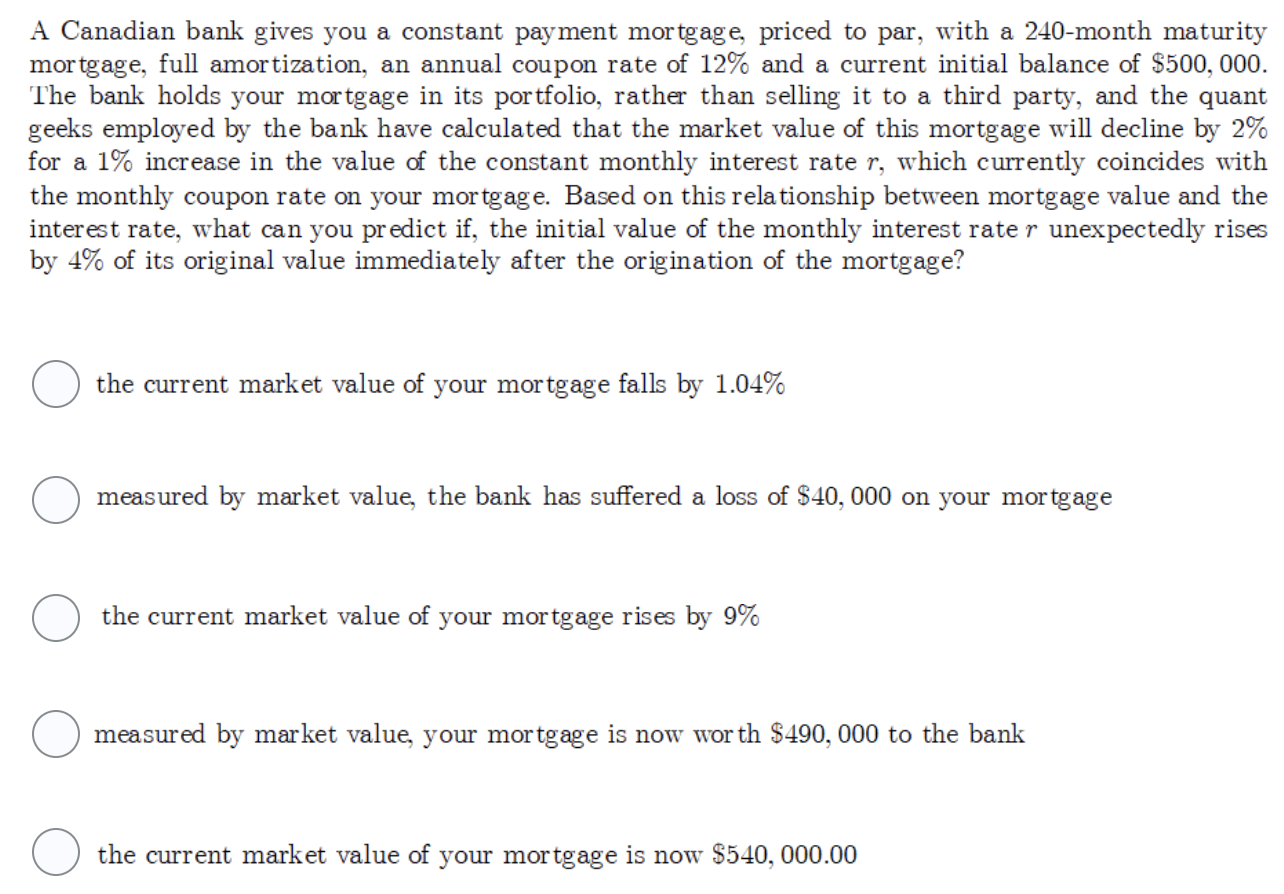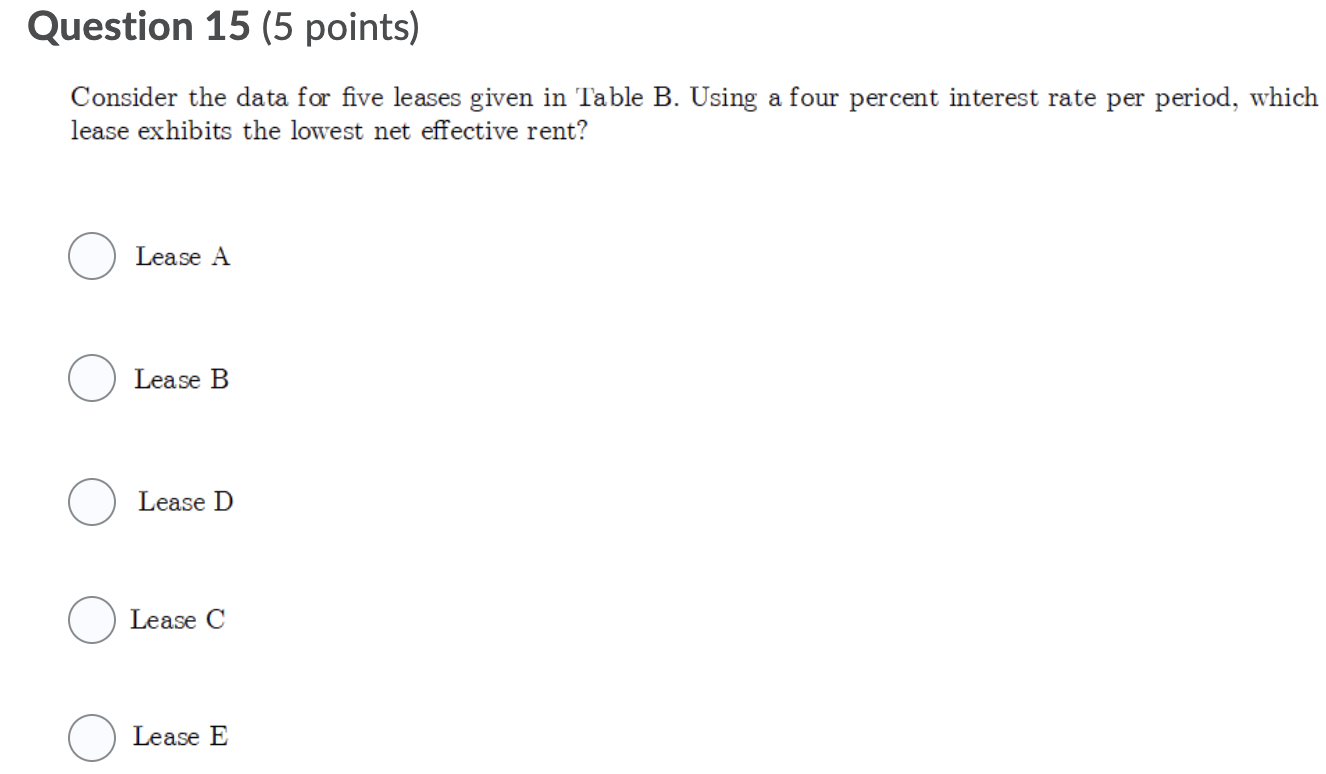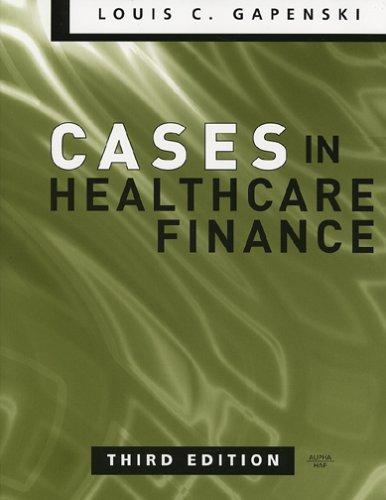


A Canadian bank gives you a constant payment mortgage, priced to par, with a 240-month maturity mortgage, full amortization, an annual coupon rate of 12% and a current initial balance of $500,000. The bank holds your mortgage in its portfolio, rather than selling it to a third party, and the quant geeks employed by the bank have calculated that the market value of this mortgage will decline by 2% for a 1% increase in the value of the constant monthly interest rate r, which currently coincides with the monthly coupon rate on your mortgage. Based on this relationship between mortgage value and the interest rate, what can you predict if, the initial value of the monthly interest rate r unexpectedly rises by 4% of its original value immediately after the origination of the mortgage? the current market value of your mortgage falls by 1.04% measured by market value, the bank has suffered a loss of $40,000 on your mortgage the current market value of your mortgage rises by 9% measured by market value, your mortgage is now worth $490,000 to the bank the current market value of your mortgage is now $540,000.00 A homeowner buys a residential property for $886,000.00 today. He takes out both first and second interest only mortgages to finance his purchase. Both mortgages have a twenty-year maturity, a 6.24% announced annual coupon rate, and respective initial balances of $546, 000.00 and $328,000.00 and he has signed a separate promissory note for each loan. Should the future market price of his property fall by an amount greater than his current equity value, he will, at that time, default on either or both of his mortgages and will face a foreclosure suit. Should this suit be successful, assume his property will sell at only 80% of its purchase price. If, however, both mortgages contain a "nonrecourse" clause, then: owing to the nonrecourse clause, the homeowner is liable for repaying the full amount of the UPB on each loan through sale of his assets other than his property none of the above owing to the nonrecourse clause, the homeowner is liable for the full amount owed to the first lender, should that lender initiate foreclosure, but only approximatey 49.63% of the UPB owed to the second lender owing to the nonrecourse clause, the homeowner is liable to repay $546,000.00 to the first lender but only approximately 49.63% of the UPB owed to the second lender owing to the nonrecourse clause, the homeowner is liable for repaying $546, 000.00 to the first lender, should that lender initiate foreclosure, but only approximatey 52.12% of the UPB owed to the second lender Question 15 (5 points) Consider the data for five leases given in Table B. Using a four percent interest rate per period, which lease exhibits the lowest net effective rent? Lease A Lease B Lease D Lease C Lease E A Canadian bank gives you a constant payment mortgage, priced to par, with a 240-month maturity mortgage, full amortization, an annual coupon rate of 12% and a current initial balance of $500,000. The bank holds your mortgage in its portfolio, rather than selling it to a third party, and the quant geeks employed by the bank have calculated that the market value of this mortgage will decline by 2% for a 1% increase in the value of the constant monthly interest rate r, which currently coincides with the monthly coupon rate on your mortgage. Based on this relationship between mortgage value and the interest rate, what can you predict if, the initial value of the monthly interest rate r unexpectedly rises by 4% of its original value immediately after the origination of the mortgage? the current market value of your mortgage falls by 1.04% measured by market value, the bank has suffered a loss of $40,000 on your mortgage the current market value of your mortgage rises by 9% measured by market value, your mortgage is now worth $490,000 to the bank the current market value of your mortgage is now $540,000.00 A homeowner buys a residential property for $886,000.00 today. He takes out both first and second interest only mortgages to finance his purchase. Both mortgages have a twenty-year maturity, a 6.24% announced annual coupon rate, and respective initial balances of $546, 000.00 and $328,000.00 and he has signed a separate promissory note for each loan. Should the future market price of his property fall by an amount greater than his current equity value, he will, at that time, default on either or both of his mortgages and will face a foreclosure suit. Should this suit be successful, assume his property will sell at only 80% of its purchase price. If, however, both mortgages contain a "nonrecourse" clause, then: owing to the nonrecourse clause, the homeowner is liable for repaying the full amount of the UPB on each loan through sale of his assets other than his property none of the above owing to the nonrecourse clause, the homeowner is liable for the full amount owed to the first lender, should that lender initiate foreclosure, but only approximatey 49.63% of the UPB owed to the second lender owing to the nonrecourse clause, the homeowner is liable to repay $546,000.00 to the first lender but only approximately 49.63% of the UPB owed to the second lender owing to the nonrecourse clause, the homeowner is liable for repaying $546, 000.00 to the first lender, should that lender initiate foreclosure, but only approximatey 52.12% of the UPB owed to the second lender Question 15 (5 points) Consider the data for five leases given in Table B. Using a four percent interest rate per period, which lease exhibits the lowest net effective rent? Lease A Lease B Lease D Lease C Lease E









